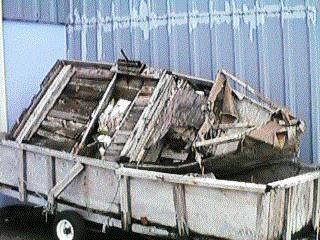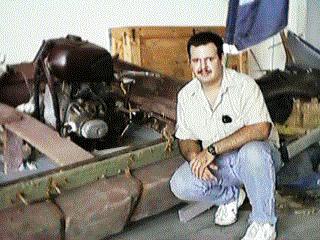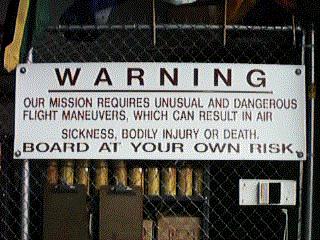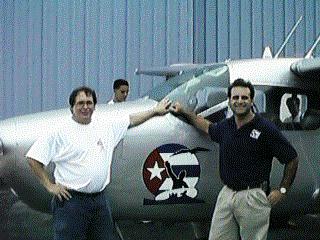 In the years since Cuba was taken over by Fidel Castro,
many of its residents have risked (and lost) their lives trying to cross the 90 mile wide
Florida Straits to Key West. Most of them don't have the luxury of coming on a
cruise ship, either! Here's one of the nicer boats was used by the refugees.
I believe this "boat" was occupied by 13 people. Dangerous ?
In the years since Cuba was taken over by Fidel Castro,
many of its residents have risked (and lost) their lives trying to cross the 90 mile wide
Florida Straits to Key West. Most of them don't have the luxury of coming on a
cruise ship, either! Here's one of the nicer boats was used by the refugees.
I believe this "boat" was occupied by 13 people. Dangerous ? Here, Rich (N2CZF) shows us the most
innovative raft we saw: a motorcycle engine and transmission (complete
with gas tank and chrome exhausts) coupled thru the hull to a propeller.
Here, Rich (N2CZF) shows us the most
innovative raft we saw: a motorcycle engine and transmission (complete
with gas tank and chrome exhausts) coupled thru the hull to a propeller. This Group has been the center
of Political controversy ever since it was started in 1991.
In February, 1996, Cuban MIG-29 jets shot down two of the BTTR aircraft over
International waters. The facts are clear about when and where the aircraft
were shot down, and that they were unarmed. I won't get into the politics-
I'll only tell the story. From this sign in the hangar, it is evident that
the danger is crystal clear!
This Group has been the center
of Political controversy ever since it was started in 1991.
In February, 1996, Cuban MIG-29 jets shot down two of the BTTR aircraft over
International waters. The facts are clear about when and where the aircraft
were shot down, and that they were unarmed. I won't get into the politics-
I'll only tell the story. From this sign in the hangar, it is evident that
the danger is crystal clear! Here's Ralph, N4NEQ (left) and Louis, N4LDG, posing with
one of the Cessna 337 aircraft that BTTR uses in their searches
for rafters in trouble! The logo represents the colors of the Cuban flag, with
a person in a raft waving for help. The seagull represents the rescue plane.
Louis is in charge of installing/maintaining the APRS equipment on the aircraft.
Here's Ralph, N4NEQ (left) and Louis, N4LDG, posing with
one of the Cessna 337 aircraft that BTTR uses in their searches
for rafters in trouble! The logo represents the colors of the Cuban flag, with
a person in a raft waving for help. The seagull represents the rescue plane.
Louis is in charge of installing/maintaining the APRS equipment on the aircraft.![[IMAGE]](prayer.jpg) Because this flight marked the six month
anniversary of the shooting down of the two BTTR airplanes, a circle of hands was made and
prayers were said. The flowers are a memorial wreath that was to be thrown into
the water at the site of the deaths of the four BTTR pilots who were shot down.
Because this flight marked the six month
anniversary of the shooting down of the two BTTR airplanes, a circle of hands was made and
prayers were said. The flowers are a memorial wreath that was to be thrown into
the water at the site of the deaths of the four BTTR pilots who were shot down.![[IMAGE]](lifevest.jpg) With any flight over water (but especially these), life jackets are required.
Here, a German TV cameraman who was going along to videotape the flight is
shown how to don his life vest.
With any flight over water (but especially these), life jackets are required.
Here, a German TV cameraman who was going along to videotape the flight is
shown how to don his life vest.![[IMAGE]](basulto.jpg)
![[IMAGE]](basulto1.jpg) These photos show the Group's founder, Jose Basulto, along with another BTTR pilot.
These photos show the Group's founder, Jose Basulto, along with another BTTR pilot.![[IMAGE]](touchdwn.jpg) Everyone breathed a sigh of relief when the last
airplane touched down after the mission. No rafters were found on this trip, but severe
thunderstorms in the air near Cuba prevented the flight from lasting as long as usual.
Everyone breathed a sigh of relief when the last
airplane touched down after the mission. No rafters were found on this trip, but severe
thunderstorms in the air near Cuba prevented the flight from lasting as long as usual.APRS Equipment used: PacComm Pico-Packet TNCs, Garmin Trackpack 35 GPSs and Kenwood radios.
Back to Ralph Fowler's Atlanta APRS Home Page
Back to Ralph Fowler's Home Page